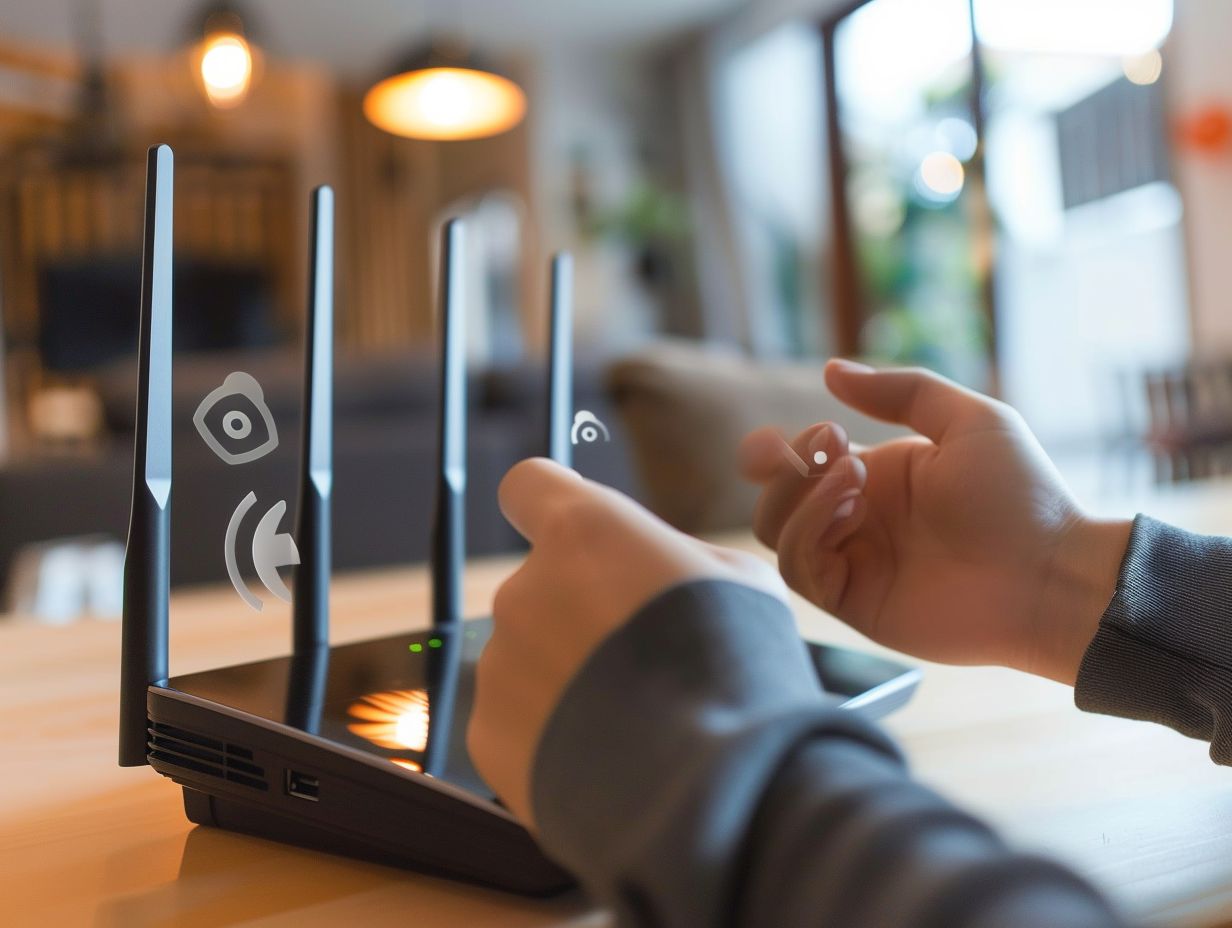In today’s digital age, it is essential that you set up and secure your wireless network effectively.
From configuring network settings to implementing strong security measures, this article will cover all the necessary information to help you safeguard your network from potential threats.
Learn about the significance of network security, adhere to the best practices for securing wireless networks, identify common security threats, and consider additional protective measures like network encryption and firewalls.
By staying informed and taking proactive steps, you can protect your data and stay ahead of potential security risks.
Key Takeaways:

Wireless Network Configuration
Wireless Network Configuration involves setting up and optimizing the various aspects of a wireless network to ensure seamless connectivity and secure data transmission. This process not only includes configuring the basic network settings like SSID and channel selection but also involves setting up encryption protocols such as WPA2 to safeguard data from unauthorized access.
Managing strong passwords and regularly updating them adds an extra layer of security. Configuring access control mechanisms like MAC filtering and setting up firewalls help in enhancing network security. Proper device authentication protocols, such as requiring devices to provide a pre-shared key, further strengthen the network against potential intrusions.
Setting up a Wireless Network
When setting up your Wireless Network, it is critical to select robust encryption standards such as WPA3, deactivate SSID Broadcast for improved security, and restrict remote administration to prevent unauthorized access.
Another crucial step in securing your wireless network is to modify the default login credentials of your router to unique and strong passwords. It is also recommended to activate firewall protection on your network to control incoming and outgoing traffic. Implementing MAC address filtering can further bolster security by permitting only specific devices to connect to the network.
Regularly updating your router’s firmware and staying informed about the latest security protocols are essential practices to ensure a resilient and secure wireless network environment.
Configuring Network Settings
Configuring Network Settings involves optimizing firewall configurations, disabling unnecessary services like UPnP, and managing MAC addresses to enhance the security and performance of your Wi-Fi network.
Firewalls serve as a critical barrier against unauthorized access to your network by filtering incoming and outgoing traffic based on predetermined security rules. Disabling Universal Plug and Play (UPnP) is essential as it can inadvertently expose your network by automatically allowing devices to communicate with each other. Implementing MAC address filtering provides an additional layer of security by whitelisting specific devices that are authorized to connect to the network. This process helps prevent unauthorized devices from gaining access and contributes to maintaining a secure network environment.
Securing Your Wireless Network
Securing Your Wireless Network is essential for protecting against unauthorized access attempts and potential cyberattacks. Incorporate advanced security measures such as MAC Filtering, WPA3 encryption, and VPN connections.
MAC Filtering is a critical method that allows you to regulate which devices can connect to your network based on their unique MAC addresses. This additional layer of security helps prevent unauthorized devices from gaining access.
Similarly, the implementation of strong encryption standards like WPA3 significantly enhances the confidentiality and integrity of data transmitted over the network. Using a VPN for secure remote access ensures that data exchanged between remote devices and the network remains encrypted and secure, especially when accessing cloud resources.
By utilizing these measures, you can effectively safeguard your network against malicious actors and potential breaches. This creates a secure and protected environment for your data and communications.
Importance of Network Security

Recognizing the importance of network security involves safeguarding against vulnerabilities such as default passwords, restricting physical access to critical network components, and managing user access to prevent unauthorized individuals from compromising the network.
You must understand that default passwords are often the weakest link in a network’s security chain. It is critical to establish strong, unique passwords for all devices and accounts. Additionally, limiting physical access to routers and switches through secure locations or access controls can prevent tampering or unauthorized changes. Controlling user permissions is another crucial aspect. By ensuring that individuals only have access to the resources necessary for their roles, the risk of data breaches or cyber attacks can be reduced. Implementing robust user authentication processes and access control mechanisms can significantly enhance an organization’s network security posture.
Best Practices for Securing Wireless Networks
Implement Best Practices for Securing Wireless Networks by creating strong passwords, restricting physical access to Wi-Fi devices, and utilizing advanced encryption protocols like WPA to strengthen network defenses against potential threats.
Strong passwords are essential as they serve as the initial line of defense, increasing the difficulty for unauthorized users to infiltrate the network. Implementing physical security measures, such as securing routers in protected areas and deactivating WPS (Wi-Fi Protected Setup) features, can deter physical interference. Encryption standards like AES (Advanced Encryption Standard) provide robust protection by encrypting data transmitted across the network. By integrating these practices, you can significantly improve the security posture of both enterprise networks and home Wi-Fi configurations.
Common Security Threats to Wireless Networks
Understanding the Common Security Threats to Wireless Networks is crucial for defending against cyberattacks, securing routers, protecting sensitive data, and preventing unauthorized access attempts by malicious actors.
One of the prevalent threats to wireless networks is the vulnerability of Wi-Fi connections, which hackers can exploit to gain unauthorized access to confidential information. Router security risks pose a major concern as misconfigured or outdated firmware can provide a gateway for cybercriminals to infiltrate the network. Data breaches are another significant danger, where sensitive data stored on network devices can be compromised, leading to severe consequences for individuals and organizations.
It is essential to stay vigilant against these threats and implement robust network defense mechanisms to safeguard against potential exploits.
Types of Attacks
Various Types of Attacks pose risks to your network security, ranging from MAC address spoofing and data interception to encryption vulnerabilities, underscoring the importance of implementing robust security measures to protect your devices and ensure proper data encryption.
Attackers often employ MAC filtering bypass techniques to evade network security measures. By spoofing legitimate MAC addresses, unauthorized devices can potentially gain access to your network, opening the door to malicious activities.
Encryption weaknesses, such as outdated encryption protocols or improperly configured settings, can expose your sensitive data to interception by cybercriminals. These vulnerabilities emphasize the necessity of continuous monitoring and updating of security protocols to defend against evolving threats in the digital landscape.
Identifying and Addressing Vulnerabilities
To identify and address vulnerabilities in your wireless networks, you need to:
- Assess the network information
- Enhance device authentication mechanisms
- Enforce strong password policies
- Secure physical access points
to strengthen your Wi-Fi network defenses.
An effective strategy is to regularly conduct penetration testing to pinpoint potential weaknesses in your wireless network infrastructure and proactively address them. Implementing intrusion detection systems can help you detect unauthorized access attempts and unusual network behavior.
Educating your users on the importance of strong password management practices and implementing two-factor authentication can significantly enhance your network security.
Physical security measures, such as restricting access to Wi-Fi routers and using secure enclosures, can also prevent unauthorized individuals from tampering with your network equipment.
Additional Security Measures

Implementing Additional Security Measures such as firewalls, access control mechanisms, virtual private networks (VPNs), and restricting remote administration is essential for thwarting unauthorized access attempts and safeguarding network resources from external threats.
Firewalls play a critical role in network security as they create a barrier between a trusted internal network and untrusted external networks. They are responsible for monitoring and filtering incoming and outgoing network traffic based on predefined security rules.
Access control policies further boost security by specifying who can access which resources within the network. The use of VPNs provides an additional layer of protection by encrypting data transmitted over public networks, ensuring confidentiality.
Limiting remote administrative privileges is also crucial in preventing unauthorized configuration changes that could compromise network integrity and expose vulnerabilities.
Network Encryption
Network Encryption plays a crucial role in securing wireless communications by using robust encryption methods such as WPA3 Security, MAC Filtering, and VPN tunnels to ensure the protection of data transmission and prevent unauthorized interception.
WPA3, the latest encryption protocol, offers significant advancements in security compared to its forerunner WPA2, providing increased protection against various cyber threats. SID Broadcast suppression adds an additional layer of defense by concealing the network’s name, thereby reducing the risk of unauthorized access.
MAC address filtering enables network administrators to manage which devices can connect to the network based on their unique MAC addresses, further strengthening security measures. Utilizing VPN tunnels establishes secure, encrypted connections over public networks, safeguarding sensitive data from potential eavesdroppers or cyber attacks.
Firewalls and Access Control
Firewalls and Access Control mechanisms serve as essential components of network security, including network-based firewalls, host-based firewalls, and the restriction of unnecessary services like UPnP to strengthen defenses against cyber threats.
Network-based firewalls are situated at the network perimeter to monitor and filter incoming and outgoing traffic based on established security rules, while host-based firewalls operate directly on individual devices to provide an additional layer of protection. By configuring firewalls to block unauthorized access and allowing only approved traffic, organizations can mitigate the risk of network intrusions.
Disabling unnecessary services like UPnP helps minimize potential vulnerabilities that malicious actors could exploit, thereby improving the overall security stance of the wireless network.
Frequently Asked Questions
What is the importance of configuring and securing wireless networks?
Configuring and securing wireless networks is crucial for protecting sensitive data and preventing unauthorized access to the network.
What are the steps involved in configuring a wireless network?

The first step is to choose the appropriate wireless technology and equipment. Then, set up the wireless access point and configure network security, such as WPA or WPA2 encryption. Finally, test the network to ensure proper functionality.
How can I secure my wireless network from potential hackers?
You can secure your wireless network by using strong and unique passwords, enabling network encryption, disabling SSID broadcasting, and regularly updating your network devices’ firmware.
What are some common security threats to wireless networks?
Some common security threats to wireless networks include eavesdropping, man-in-the-middle attacks, denial of service attacks, and rogue access points.
Do I need to regularly update the security settings on my wireless network?
Yes, it is important to regularly review and update the security settings on your wireless network to stay protected against new and evolving threats.
Can I configure and secure my wireless network without any technical knowledge?
While it is recommended to seek professional help for configuring and securing wireless networks, there are user-friendly tools and resources available that can guide you through the process.
